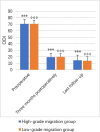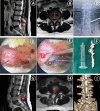One-hole split endoscope technique for migrated lumbar disc herniation: a single-centre, retrospective study of a novel technique
- PMID: 37408054
- PMCID: PMC10324176
- DOI: 10.1186/s13018-023-03967-3
One-hole split endoscope technique for migrated lumbar disc herniation: a single-centre, retrospective study of a novel technique
Abstract
Background: Lumbar disc herniation (LDH) is one of the most common diseases of the spine, and migrated LDH is a more serious type, associated with nerve root function injury or abnormality. Regarding the increasing surgery adoption of treating migrated LDH, we aimed to investigate the clinical efficacy and safety of discectomy with a novel technique-one-hole split endoscope (OSE) technique.
Methods: This was a retrospective analysis of migrated LDH treated between December 2020 and September 2021. Hospitalization time, operative duration, intraoperative blood loss, number of fluoroscopy exposures, incision length, postoperative facet preservation rate, number of excellent-good cases, lower back and leg visual analogue score (VAS), Oswestry Disability Index (ODI) and surgical complications were compared between high-grade migration group (82 cases) and low-grade migration group (148 cases). The Macnab criteria was used to evaluate the clinical outcome. The Shapiro‒Wilk test was used to test measurement data, and the χ2 test was used to test counting data.
Results: There was no significant difference in hospitalization time, operative duration, intraoperative blood loss, number of fluoroscopy exposures, incision length or postoperative facet preservation rate between the two groups by independent sample t test or nonparametric test. At any time point, the lower back and leg VAS and ODI of the two groups were significantly improved compared to those before the operation, but there was no significant difference between the two groups at the same time point by two-way repeated measures ANOVA. There were two cases of postoperative nerve root stimulation symptoms in the high-grade migration group and three cases in the low-grade migration group. There was one patient reoperated in the high-grade migration group. There was no significant difference in number of excellent-good cases between the two groups. The overall excellent-good rate was 89.6%.
Conclusion: The OSE technique has the advantages of less trauma, faster recovery, complete removal of the nucleus pulposus and a satisfactory early clinical efficacy in the treatment of migrated LDH.
Keywords: Clinical efficacy; Complication; Migrated lumbar disc herniation; One-hole split endoscope technique.
© 2023. The Author(s).
Conflict of interest statement
The authors declare that the research was conducted in the absence of any commercial or financial relationships that could be construed as a potential conflict of interest.
Figures




References
MeSH terms
LinkOut - more resources
Full Text Sources
Medical

